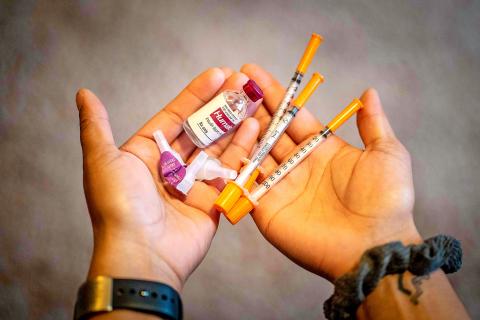On a frosty morning last month in a Minneapolis suburb, Abigail Hansmeyer left her car engine running and took out a brown paper bag carrying needles and a vial, handing it over to its recipient in an anonymous shopping center parking lot.
The exchange is technically illegal, but these are not illicit drugs. Instead, the vial contains insulin: A medicine that has since its discovery in the 1920s transformed a diagnosis of diabetes from a swift death sentence to a manageable disease.
Yet, its price has skyrocketed in the US over the past decade, creating informal networks of people who build up stockpiles and give to others what they do not need themselves.

Photo: AFP
“Thank you so much,” 52-year-old Annette Gentile said as she took the bag from Hansmeyer, checking the labels and doses.
“I’ve been on a roller coaster in the last few days,” she added, because of her elevated blood sugar levels.
Gentile does not live in abject poverty. She receives a monthly disability allowance of US$1,200 and has public health insurance.
However, crucially, that insurance does not cover prescription medicine.
The contents of the bag she just received, which will keep her going for a month, would cost her about US$1,000 at a pharmacy.
“I purely rely on donations,” she said.
Her benefactor, 29-year-old Hansmeyer, is unemployed and has type 1 diabetes, a chronic condition that appears in childhood in which the pancreas produces little or no insulin, the hormone that lets sugar enter cells to produce energy.
People who have it need to inject themselves with insulin several times each day for the rest of their lives.
Both women are part of a group of diabetics who connect with each over Facebook or text messages to hand out or receive their prized medication, free of cost, sometimes using code words like “lifewater” to evade detection.
Nearly all of the stock that circulates comes from the relatives of patients who died.
For US President Donald Trump’s rivals in the Democratic Party, who tomorrow begin their primary contests in Iowa, there are few scandals greater than the price of insulin: The epitome of pharmaceutical price-gouging that blights the US healthcare system.
“We’re not poor,” Hansmeyer said.
Her husband works and has started a small business, she has her own car and the couple live in a house that pet dogs and rabbits also call home.
However, her husband’s employer does not subsidize its workers health insurance. Not poor enough to qualify for state insurance and not rich enough to buy their own, the couple gave up looking last month.
They joined the ranks of the 27.5 million Americans without coverage, praying that no calamity befalls them.
“My entire adult life I’ve gone in and out of rationing my insulin,” Hansmeyer told reporters.
She said that she remembers crying with happiness a few years ago, when she won a battle against her then insurer for an insulin pump, a computerized device that continuously releases the right amount of the hormone.
Hansmeyer acts as a go-between for her community of Minneapolis-area diabetics, connecting those in need with those who have. One of her major sources is a refrigerator in the basement of a house belonging to Nicole Smith-Holt.
Smith-Holt opened its door to reveal a treasure trove: Dozens of vials of insulin and a large stock of syringes, test strips and other supplies. She guessed its value at about US$50,000.
“It is strictly illegal,” she said.
Selling or even giving away prescription medicine is technically a minor crime, but for Smith-Holt, it is a cause that is devastatingly close to her heart.
“We don’t need another Alec,” she said, referring to her son who died in June 2017.
Alec Raeshawn Smith was covered by his mother’s insurance until he turned 26, the age up to which insurers are obliged under a law enacted by former US president Barack Obama to allow adult children to remain covered by their parent’s plans.
After crossing that threshold, he found himself unable to afford his own insurance on his meager salary as a restaurant worker. He died 27 days after his insurance lapsed from diabetic ketoacidosis as a result of a lack of insulin.
There was not a drop of insulin to be found in his apartment, Smith-Holt said, but added that there was evidence her son had tampered with his insulin pens to try to squeeze out every last bit.
“I think until I take my last breath I’ll feel a sense of guilt in some sort of way,” Smith-Holt said. “I wish he would have asked for help.”
The death of her son, who was himself a father, transformed Smith-Holt into an activist. One day she is on TV, the next she is lobbying local politicians, or protesting outside a pharmaceutical company.
Further to the north, diabetics can look to providers on the right side of the law, but the wrong side of the border: Canadian pharmacies.
Unlike the US, Canada caps the price of insulin. Every three months, alone or with others, 47-year-old Travis Paulson makes the two-hour drive from Eveleth in northern Minnesota to Fort Frances in Canada’s Ontario Province, crossing the Rainy River to buy his insulin without prescription.
Customs agents do not bother him as long as his supply is less than three months’ worth.
His insurance is excellent as far as doctor visits go, but only pays half the price of medicines.
He pulled out two almost identical vials of insulin: one is labeled NovoLog and costs US$345 in the US, with his insurance leaving him responsible for half the bill.
The Canadian vial is sold under the brand name NovoRapid and costs about US$25. The math is not hard.
“It’s pharmaceutical greed. It’s greed is all it is, simple as that,” he said.
A sticker for US Senator Bernie Sanders on his fridge shows off Paulson’s support for the self-professed democratic socialist, who has vowed to cut drug costs in half.
However, even that might not be enough to reduce the appeal of his Canadian road trips.

BYPASSING CHINA TARIFFS: In the first five months of this year, Foxconn sent US$4.4bn of iPhones to the US from India, compared with US$3.7bn in the whole of last year Nearly all the iPhones exported by Foxconn Technology Group (富士康科技集團) from India went to the US between March and last month, customs data showed, far above last year’s average of 50 percent and a clear sign of Apple Inc’s efforts to bypass high US tariffs imposed on China. The numbers, being reported by Reuters for the first time, show that Apple has realigned its India exports to almost exclusively serve the US market, when previously the devices were more widely distributed to nations including the Netherlands and the Czech Republic. During March to last month, Foxconn, known as Hon Hai Precision Industry

Taiwan Semiconductor Manufacturing Co (TSMC, 台積電) and the University of Tokyo (UTokyo) yesterday announced the launch of the TSMC-UTokyo Lab to promote advanced semiconductor research, education and talent development. The lab is TSMC’s first laboratory collaboration with a university outside Taiwan, the company said in a statement. The lab would leverage “the extensive knowledge, experience, and creativity” of both institutions, the company said. It is located in the Asano Section of UTokyo’s Hongo, Tokyo, campus and would be managed by UTokyo faculty, guided by directors from UTokyo and TSMC, the company said. TSMC began working with UTokyo in 2019, resulting in 21 research projects,

Ashton Hall’s morning routine involves dunking his head in iced Saratoga Spring Water. For the company that sells the bottled water — Hall’s brand of choice for drinking, brushing his teeth and submerging himself — that is fantastic news. “We’re so thankful to this incredible fitness influencer called Ashton Hall,” Saratoga owner Primo Brands Corp’s CEO Robbert Rietbroek said on an earnings call after Hall’s morning routine video went viral. “He really helped put our brand on the map.” Primo Brands, which was not affiliated with Hall when he made his video, is among the increasing number of companies benefiting from influencer

Quanta Computer Inc (廣達) chairman Barry Lam (林百里) yesterday expressed a downbeat view about the prospects of humanoid robots, given high manufacturing costs and a lack of target customers. Despite rising demand and high expectations for humanoid robots, high research-and-development costs and uncertain profitability remain major concerns, Lam told reporters following the company’s annual shareholders’ meeting in Taoyuan. “Since it seems a bit unworthy to use such high-cost robots to do household chores, I believe robots designed for specific purposes would be more valuable and present a better business opportunity,” Lam said Instead of investing in humanoid robots, Quanta has opted to invest